The Crystals
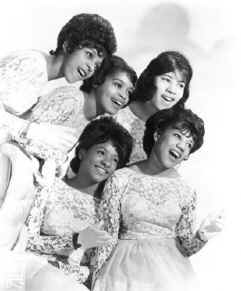
Top row: Barbara Alston, Mary Thomas,
Patsy Wright
Bottom row: Dee Dee Kennebrew, LaLa Brooks
One of the most popular of the 60s girl groups, the Crystals were
the first act that producer Phil Spector gave full attention to
while establishing his Philles label
Members
(1961) Dolores
Kennibrew - 1st soprano
Patsy Wright - 2nd Soprano/Lead
Barbara Alston- 1st
Alto/Lead
Myrna Gerard - 1st Alto
Mary Thomas - 2nd Alto |
(1961-63) Dee Dee
Kenniebrew
Patsy Wright
Barbara Alston
Mary Thomas
Dolores Brooks |
(1963) Barbara Alston
Dolores Brooks
Dee Dee Kenniebrew
Patsy Wright
|
(1964) Barbara
Alston
Delores Brooks
Francis Collins
Dee Dee Kenniebrew
|
(1965-66) Delores Brooks
Francis Collins
Dee Dee Kenniebrew
|
(1967) Barbara Alston
Dee Dee Kenniebrew
Mary Thomas
|
This group was not your typical collection of
girlfriends singing together in the neighborhood; they were
mostly from different sections of Brooklyn. The eventual quintet
was a creation of Benny Wells, a former big-band musician and by
1960, the groups manager. Wells rehearsed his acts in P.S. 73 on
MacDougall Street.
Deciding in the fall of 1960 to form a group,
Wells recruited his niece, seventeen year Barbara Alston, from
Lexington Avenue in the Bedford-Stuyvesant section of Brooklyn.
Kate Henry who worked at P.S. 73, brought in her 15 year old
daughter Delores (Dee Dee) Kennibrew, who lived on Bergen Street
in the Crown Heights section and went to Wingate High School.
Alston recommended 17 year old Mary Thomas of Sumner Avenue
in Williamsburg and 17 year old Merna Girard of Kingston Avenue.
Since Wells didn't write, he got his material
from various songwriters such as Skank Avenue's Leroy Bates. When
the group wasn't rehearsing at P.S. 73 they'd go to Bate's
sister-in-law's house where there was a piano. His sister-in-law,
17 year old Pat Wright of Bushwick High School became the fifth
member. They became the Crystals when they named themselves after
Bate's baby daughter "Crystal" Bates.
Early in 1961 Wells took the group to the
Celebrity Club in Freeport, Long Island, to get the feel of a
stage and live performing. This would be the group's only public
appearance until after their first record. Still looking for hit
material Wells met Hill and Range songwriters Bill Grant and
Bernie Baum, who arranged for the girls to rehearse at the
publishing company's offices in midtown Manhattan.
While rehearsing "There's No Other" one
evening in March, 1961 the group met Phil Spector. Originally
done uptempo, Spector slowed it down, creating an entirely
different feel.
Continuing to rehearse until late June, they were
finally called in to Mira Sound on West 47th Street in New York
City to record on the night of their high school graduation prom.
Barbara, Mary, and Myrna showed up at the studio after 10P.M.,
still in the prom dresses that they wore at Commercial High
School prom, to record "There's No Other" and "Oh
Yeah, Maybe Baby." The scheduled September release had
"Oh Yeah" as the A side.

Crystals 1961
(L-R) Barbare Alston, Mary
Thomas, Patsy Wright, Dee Dee Kenniebrew, and Delores
Brooks
The first in a series of surprising events in the
Crystal's career happened when the record came out not on Liberty
as they had expected.( since Spector was involved with that
label) or even Big Top (which was affiliated with Hill and Range,
for which Spector was expected to do some production work for).
It came out on Philles, a label started by Spector and Lester
Sill. By the time it reached radio, "There's No Other"
with it's solo intro by Barbara and Chantels styled harmony, was
the popularly elected A side. The record entered Billboard's Pop
listings on November 20th and peaked at number 20 in January
1962, also hitting number five R&B. Their first live
performance was at the Apollo Theatre.
Influenced by the Bobbettes, the Chantels, and
the Shirelles, Spector was reshaping the Crystal's sound to
redefine the girl group style. The first indication of this was
with their second single, the Mann/Weil written
"Uptown." The song was about a battle weary man who
finds strength and pride when he comes "uptown' to her arms,
was ahead of it's time in it's raw realism. At this time there
were six Crystals; 16 year old LaLa Brooks had been brought in to
replace the pregnant Merna Gerard.
Uptown hit the charts in the same month of it's
release March, 1962. It reached number 13 Pop and 18 R&B.
Spector chose to let the instruments overshadow the voices on
this brilliant recording that just stopped short of being too
busy.
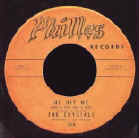
jpg courtesy The Phil Spector Label Gallery
Their next song "He Hit Me (and It Felt Like
A Kiss), was written by Carole King and Gerry Goffin, was based
on a story their babysitter had told them about being beaten by
her boyfriend. (The babysitter was Eva Boyd, who by August would
have a number one record "The Locomotion," under the
name of Little Eva that was written by Goffin and King.
The production of "He Hit Me" was
another step closer to Spector's eventual "Wall of
Sound" approach
Despite it's good reviews and instant airplay the
Crystals hated it and so did Spector's partner Lester Sill,
feeling it was a depressing, negatively influenced song. Most of
the public never got a chance to decide; as watchers of the
nation's morals began complaining to the radio stations over the
lyrics.
Philles immediately pulled the record.
The Crystal's next career surprise was a
recording of "He's A Rebel," a song previously turned
down for the Shirelles by Sceptor Records' head Florence
Greenberg as being to adventurous.
From "Uptown" on he would bring
in tracks, not finished, but enough for you to put your own part
down, so he would do everything in segments, so I could not tell
you how or what he kept of ours ......Dee Dee Kennibrew
What Spector did keep on this Gene Pitney song
was Darlene Love and the Blossoms vocals. Spector felt "He's
A Rebel' would sound better would sound better with a with the
powerful lead voice of session singer Darlene (Wright) Love.
Wright's fiery vocal, straight out of the
Pentecostal choir, was exactly the sound Spector wanted for this
celebration of nonconformity.
"He's A Rebel" came out in August, 1962
immediately after "He Hit Me" and listed the Crystals
as the artists. The reached number one the week of November 3,
1962. (The number two record that week was Gene Pitney's
"Only Love Can Break a Heart"). The song became an
anthem for teen girls who secretly longed for good hearted bad
guys. With their biggest hit, the Crystals weren't sure if any of
their harmony work was used.
After "He's A Rebel" Mary left the
group to get married and the group would remain a quartet.
The Crystal's next single "He's Sure the Boy
I Love," with another successful spoken intro
Mann/Weil
song #11 pop 1963, #18 R&B"). Again Darlene Love and
the Blossoms were the actual performers.
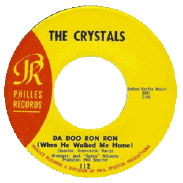
Now deciding that he preferred La La Brook's lead
voice to Alston's and Wright's, in March 1963, Spector flew her
Brooks to Los Angeles to do lead vocals over Darlene Love's
original tracks on the Barry/Greenwich/Spector song, "Da Doo
Ron Ron".
Released in April under the Crystals' name, it
was basically Brooks and the Blossoms. By the week of June 8th,
it had reached number three on the charts.
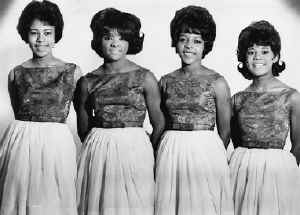
Crystals 1963
L to R: Patsy Wright, Delores
Brooks, Barbara Alston and Dee Dee Kennibrew
Their seventh single, entirely by the Crystals,
was "Then He Kissed Me" another Barry/Greenwich/Spector
song and entered the Billboard Top 100 on August 17. This song
established the "wall of sound."
By September 14th it was six Pop and number eight
R&B at a time when seven out of the top ten records were by
British groups.
January 1964, the Crystals released "Little
Boy." Over produced, a fine arrangement and song was wasted.
Also, Philles was now preoccupied with it's newest talents, the
Ronettes. "Little Boy" saw little airplay and reached
no higher than 92 in February.
By now, Pat had left to get married and was
replaced by Frances Collins.
Their last Spector record "All Grown
Up" had been recorded the year before. It reached number 98
on August 1, 1964.
In 1965 the Crystals signed with United Artists
Records and released two singles which went nowhere. Soon
thereafter Barbara married; the Crystals split up around 1967.
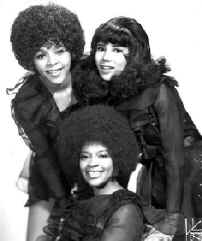
The Crystals 1972
(clockwise from top left) Barbara Alston, Dee Dee Kenniebrew,
Mary Thomas
Dee Dee also got married, but around 1971 she
reformed the group with LaLa, Mary, and Barbara for a Richard
Nader rock and roll revival show. From 1971 to 1973 they toured
and performed until motherhood and husbands once again took over.
Barbara left after a 1973 U.K. tour, but Dee Dee kept performing
with two new Crystals. LaLa now lives in Vienna, Austria with her
jazz musician husband (her high school sweetheart). Barbara is
married in Brooklyn with four children. Pat married a serviceman
and lives out west. Dee Dee, when not touring, lives in Atlanta.
The Crystals were inducted into the Vocal Group
Hall of Fame in 2005
Barbara Alston passed away February 16, 2018 in
Charlotte, North Carolina from the flu.







